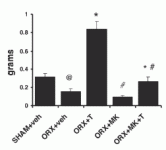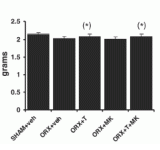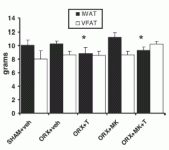Combined with DHT blocker testosterone is still anabolic
Steroids users who want to avoid androgenic effects sometimes add substances like finasteride to their testosterone courses. Finasteride inhibits the conversion of testosterone [structural formula shown below] into the androgen DHT [structural formula below that of testosterone]. DHT has a greater effect on hair loss and prostate hypertrophy than testosterone. In 2005 physiologists at the University of Florida showed in an animal study that DHT blockers hardly reduce the anabolic effects of testosterone.
At first sight testosterone is the ideal product to treat older men who are losing muscle mass and strength, bone mass and sex drive. But the problem with testosterone is that it enlarges the prostate and thereby increases the chance of developing prostate cancer. So can you prevent this from happening by inhibiting the conversion of testosterone into DHT? And if you do this, does testosterone still work effectively? These were the questions the Americans wanted to answer.
When it came to the DHT blocker, the researchers used MK-434 instead of finasteride. MK-434 is an experimental DHT blocker produced by Merck. Like finasteride, MK-434 blocks the enzyme 5-alpha-reductase, but does so more effectively. The researchers gave the MK-434 for four weeks to castrated rats, some of which had had a testosterone implant and others had not. The implant released 1 mg of testosterone daily. Rats are not that big, so one milligram is a high dose.
The table below shows what happened to the prostate in the test animals. ORX = castrated rats; SHAM = intact rats.
Testosterone caused a 5.4 factor increase in the weight of the prostate. But adding MK-434 got rid of the growth-enhancing effect on the prostate.
Blocking the formation of DHT hardly caused any reduction in the anabolic effect of the course of testosterone, however. The figure below shows what happened to the mass of the gastrocnemius muscle.
A*raised testosterone level leads to fat mass reduction. Adding the DHT blocker partly reduced that effect. The amount of subcutaneous fat [IWAT] did go down in the rats that got testosterone and MK-434, but the abdominal fat [VFAT] did not.
"Our results suggest that administration of higher doses of testosterone in combination with a 5-alpha-reductase inhibitor might be a safe and effective strategy for combating sarcopenia in elderly men", the researchers conclude.
In doping circles it's not done to develop cycles of steroids that relieve the prostate. Perhaps it's time to reconsider this, if we look at the figures the researchers quote from the literature: "Approximately 10 per cent of men will develop clinically manifested prostate cancer in their lifetime, and 3 per cent will die of the disease. However, autopsy data show that 42 per cent of men over the age of 60 have early-stage prostate cancer."
Source:*
Am J Physiol Endocrinol Metab. 2005 Jan; 288(1):E222-7.



Steroids users who want to avoid androgenic effects sometimes add substances like finasteride to their testosterone courses. Finasteride inhibits the conversion of testosterone [structural formula shown below] into the androgen DHT [structural formula below that of testosterone]. DHT has a greater effect on hair loss and prostate hypertrophy than testosterone. In 2005 physiologists at the University of Florida showed in an animal study that DHT blockers hardly reduce the anabolic effects of testosterone.
At first sight testosterone is the ideal product to treat older men who are losing muscle mass and strength, bone mass and sex drive. But the problem with testosterone is that it enlarges the prostate and thereby increases the chance of developing prostate cancer. So can you prevent this from happening by inhibiting the conversion of testosterone into DHT? And if you do this, does testosterone still work effectively? These were the questions the Americans wanted to answer.
When it came to the DHT blocker, the researchers used MK-434 instead of finasteride. MK-434 is an experimental DHT blocker produced by Merck. Like finasteride, MK-434 blocks the enzyme 5-alpha-reductase, but does so more effectively. The researchers gave the MK-434 for four weeks to castrated rats, some of which had had a testosterone implant and others had not. The implant released 1 mg of testosterone daily. Rats are not that big, so one milligram is a high dose.
The table below shows what happened to the prostate in the test animals. ORX = castrated rats; SHAM = intact rats.
Testosterone caused a 5.4 factor increase in the weight of the prostate. But adding MK-434 got rid of the growth-enhancing effect on the prostate.
Blocking the formation of DHT hardly caused any reduction in the anabolic effect of the course of testosterone, however. The figure below shows what happened to the mass of the gastrocnemius muscle.
A*raised testosterone level leads to fat mass reduction. Adding the DHT blocker partly reduced that effect. The amount of subcutaneous fat [IWAT] did go down in the rats that got testosterone and MK-434, but the abdominal fat [VFAT] did not.
"Our results suggest that administration of higher doses of testosterone in combination with a 5-alpha-reductase inhibitor might be a safe and effective strategy for combating sarcopenia in elderly men", the researchers conclude.
In doping circles it's not done to develop cycles of steroids that relieve the prostate. Perhaps it's time to reconsider this, if we look at the figures the researchers quote from the literature: "Approximately 10 per cent of men will develop clinically manifested prostate cancer in their lifetime, and 3 per cent will die of the disease. However, autopsy data show that 42 per cent of men over the age of 60 have early-stage prostate cancer."
Source:*
Am J Physiol Endocrinol Metab. 2005 Jan; 288(1):E222-7.




